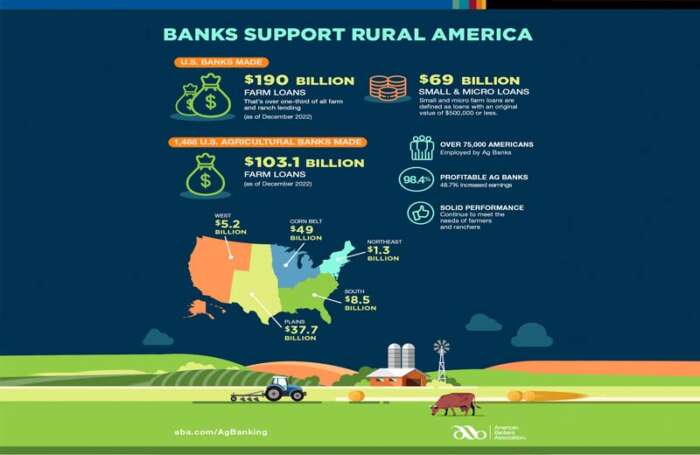According to the American Bankers Association’s (ABA) annual Farm Bank Performance Report, lending by U.S. farm banks increased to a record high of $103.1 billion in 2022, an 8.1% increase over the previous year.
Despite supply chain disruptions, volatility in commodity prices, geopolitical uncertainty, and other challenges, the report noted that the outstanding loans secured by farmland and agricultural production loans were the driving factors behind the increase in lending.
Loans Secured by Farmland, Agri Production Loans
The ABA report highlighted that the 9.7% increase in outstanding loans secured by farmland and a 5.9% increase in agricultural production loans were the main drivers of the lending increase. The report also found that farmland continues to provide a strong equity base for producers, with land values seeing strong growth in 2022 after plateauing for several years.
Farm Bank Lending Major Credit Source
The report revealed that farm banks are a major source of credit to small farmers, holding over $43.8 billion in small farm loans, including $9.3 billion in micro farm loans at the end of 2022. Noncurrent loans at these banks stood at $1.5 billion at year-end 2022, representing 0.49% of the loan portfolio of farm banks. The median noncurrent loan ratio for farm banks dropped by 14 basis points to 0.19%, compared to the noncurrent loan ratio of the broader banking sector, which was 0.24%.
Regional Summaries of Bank Performance
The ABA report provided regional summaries of farm bank performance, showing that the Northeast region’s nine banks decreased farm loans by 13.08% to $1.3 billion in 2022, while the South region’s 137 banks increased farm loans by 11.98% to $8.5 billion in 2022. The 694 Cornbelt region’s banks increased farm loans by 8.83% to $49.0 billion in 2022, while the Plains region’s 574 banks increased their farm loans by 5.98% to $37.7 billion in 2022. The West region’s 45 farm banks increased their farm loans by 10.47% to $5.2 billion in 2022.
Strong Asset Quality and Healthy Capital Levels
The report also noted that farm banks remain well-positioned to continue serving the needs of their customers and communities, with strong asset quality and healthy capital levels. Equity capital at farm banks decreased 15.4% to $41.9 billion in 2022, while Tier 1 capital increased 8.7% to $50.9 billion.

The Farm Bank Performance Report Regional Summaries
- Northeast Region 9 banks decreased farm loans by 13.08% to $1.3 billion in 2022. Ag production loans fell 2.96% from 2021, farmland loans increased 14.53%.
- South Region 137 banks increased farm loans by 11.98% to $8.5 billion in 2022. Ag production loans rose 14.87% from 2021, farmland loans rose by 11.00%.
- Cornbelt region 694 banks increased farm loans by 8.83% to $49.0 billion in 2022. Ag production loans rose by 7.44% from 2021, farmland loans rose by 9.80%.
- Plains region 574 banks increased farm loans by 5.98% to $37.7 billion in 2022. Ag production loans rose 2.51% from 2021, farmland loans increased 9.07%.
- West region 45 banks increased farm loans by 10.47% to $5.2 billion in 2022. Ag production loans rose by 13.86% from 2021, farmland loans rose 8.27%.
- Read more
Key Takeaways
- Agricultural lending by U.S. farm banks increased by 8.1% in 2022 to reach a record high of $103.1 billion.
- Outstanding loans secured by farmland and agricultural production loans drove the increase in lending.
- Farmland continues to provide a strong equity base for producers to tap, with land values seeing strong growth in 2022.
- Farm banks are a major source of credit to small farmers, holding over $43.8 billion in small farm loans, including $9.3 billion in micro farm loans at the end of 2022.
- Asset quality at farm banks improved in 2022, with low measures of loan delinquency.
- The entire banking industry held nearly $190 billion in farm and ranch loans at the end of 2022.
- The Northeast region saw a decrease in farm loans, while the South, Cornbelt, Plains, and West regions all saw increases.
- Farm banks remain well-positioned to serve the needs of their customers and communities with strong asset quality and healthy capital levels.
Conclusion
The ABA report shows that the U.S. banking industry is a major source of funding to small farmers, with small loans continuing to make up over a third of banks’ farm and ranch lending, including over $69 billion in small and micro farm and ranch loans on the books at the end of 2022. Despite challenges, farm banks added more than 800 jobs in 2022, a 1.1% increase, and employed more than 75, 000 rural Americans.



